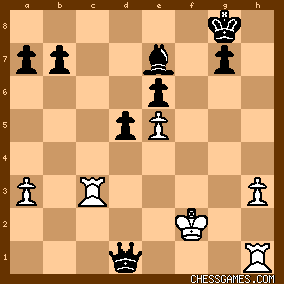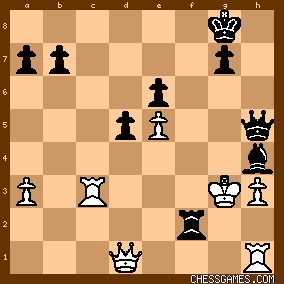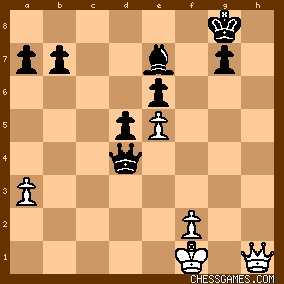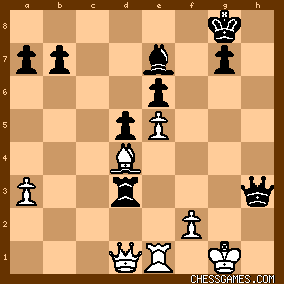|
< Earlier Kibitzing · PAGE 1 OF 2 ·
Later Kibitzing> |
Nov-06-12
 | | Phony Benoni: The key is realizing that White's queen isn't that well-protected, since the king can be forced to the first rank after 28...Rxf2+ 29.Bxf2 Rxf2+ due to 30.Kg3 Bh4#. (Yes, 30...Qg4# is OK, but the bishop mate seems prettier.) Is there a mate after 30.Kg1 Qxd1+ 31.Kxf2 Bh4+? Yes afte 32.Kg2, but after 32.Ke3 it looks like Black has to settle for the rook and leave the blood lust for later. |
|
| Nov-06-12 | | MountainMatt: Thanks Phony. How awful is it that it took me 8 whole minutes to work all that out? I mean, I did get the puzzle, so I'm half-happy...but 8 minutes?!? |
|
Nov-06-12
 | | Fusilli: 28...Qxh3+ 29.Kg1 Qg4+ followed by (wherever the king goes) 30...Rxf2+ also wins, no? In fact, after 30.Kf1 Rxf2+ 31.Bxf2 Qxd1+ 32.Kg2 Rxf2+ 33.Kxf2 Qxh1 the butchered landscape is similar to <PB>'s line, but with an extra pawn for Black. <PB> You mean 30...Qh4# :) |
|
Nov-06-12
 | | Sneaky: I was too mesmerized with ...Qxh3+ to look at anything else. |
|
| Nov-06-12 | | Abdel Irada: <Putting the "b" in "subtle"<<<>>> Let's face it: With a pawn already in hand and another free for the taking, and heavy pieces bearing down on White's king, Black can take his pick of ways to win. And most of them are about as subtle as a sledgehammer to the face. Preferring to sacrifice his opponent's pieces, Black begins <28. ...Qxh3†
29. Kg1, Qg4†<>> Now White gets to decide which side of his skull he wants crushed. <(1) <30. Kh2, Rxf2†
31. Bxf2, Rxf2#>
That was short and not-so-sweet. How about running the other way? <(2) 30. Kf1, Rxf2†<>> Again White has a choice of grim fates.
<(2.1) 31. Bxf2, Qxd1†
32. Kg2, Rxf2†
33. Kxf2, Qxh1  <>> <>> Black's first rook sac on f2 worked so well he did it again, emerging with queen, bishop and three pawns for a rook. White isn't dead, but he's in a terminal coma and on life support — until someone mercifully pulls the plug. One last hope: Can the king take refuge next to his bride? <(2.2) 31. Ke1, Qe4†
32. Re3/Be3, Qxh1#>
The answer is yes and no. He will lie next to her, but only /in articulo mortis/. Here's to Annabel Lee! And may a merciful heaven preserve her from a bridegroom named M. Valdemar. As Montresor would say, "In pace requiescat." |
|
| Nov-06-12 | | M.Hassan: "Easy"
Black to play 28....?
Black is a pawn up
28..........Rxf2+
29.Bxf2 Rxf2+
<if 30.Kg3 Bh4#>
30.Kg1 Qxd1+
31.Kxf2 Qxh1
White is way behind in materials and would be better to resign.
Interesting puzzle and IMO easier than last night. |
|
Nov-06-12
 | | al wazir: I found the win with 28...Qxh3+ 29.Kg1 Qg4+, etc., but not the game line. |
|
| Nov-06-12 | | rilkefan: I found this inordinately hard for a Tuesday, in part because I went down various winning lines and thought each was taking too long. |
|
| Nov-06-12 | | mmousez: Can Black still win if White had played 28. Rxf3 instead of the game's 28. Rh1?
I can't find an immediate win (ok, Black is up 2 pawns). |
|
| Nov-06-12 | | Once: There is an interesting little finesse at the end of the game line: 28... Rxf2+ 29. Bxf2 Rxf2+ 30. Kg1 (30.Kh1?? Qg4# or <phony's> prettier Bh4#) 30... Qxd1+ 31. Kxf2 Our forced sequence leads us to here, with white to move: 
click for larger viewNow 31... Qxh1 might seem like the obvious move. White grabs a huge material advantage and ought to win comfortably. But I think this is the wrong rook to grab. It leaves white with the Rc3 sitting on an open file. For all we know, white might be able to cause mischief with Rc7 or Rc8+. So I think a stronger move would be 31... Qd2+ followed by Qxc3. It leaves the Rh1 sitting on the back rank staring at a pawn's backside. What's more, if white responds to 31...Qd2+ with Kg1 or Kf1, he is blocking his rook in still further. And if he runs to the third rank we take on c3 with check. Fritzie, being a cold and heartless beast, points out that 31...Bh4+ works just as well. But I think 31...Rd2+ is easier for us humings. |
|
| Nov-06-12 | | TheBish: P Petrowitsch vs C Orpinas, 1993 Black to play (28...?) "Easy", Black is up a pawn.
Just a little more involved than yesterday's. Candidates are ...Qxh3+ and ...Rxf2+. Both seem to work! 28...Qxh3+ 29. Kg1 Qg4+ 30. Kf1 (or 30. Kh2 Rxf2+ 31. Bxf2 Rxf2#) Rxf2+ 31. Bxf2 (or 31. Ke1 Rf1+! 32. Rxf1 Rxf1+ 33. Kxf1 Qxd1+ 34. Kg2 Qxd4) 31...Qxd1+ 32. Kg2 Rxf2+ 33. Kxf2 Qxh1, with a queen and bishop for a rook. 28...Rxf2+ 29. Bxf2 (not 29. Kg3 Qh4#, or 29. Kg1 Qxd1#) Rxf2+ 30. Kg1 Qxd1+ 31. Kxf2 Qxh1, again with a queen and bishop for a rook. I suppose the second option (28...Rxf2+) is slightly more accurate (or at least simpler), since it wins the same material (minus a pawn) as the first option (28...Qxh3+) in two fewer moves. But a win is a win, so I think both are equally good. |
|
| Nov-06-12 | | stacase: Took me way to long to see the correct sequence. |
|
| Nov-06-12 | | morfishine: A little squirrely with White's DSB covering <f2> and the Queen Rook
contesting the third rank from <c3>. Nonetheless, Black has two forcing and winning lines: (1) <28...Qxh3+ 29.Kg1 Qg4+> White has two replies, both failing: (1a) <30.Kh2> and Black wins with <30...Rxf2+ 31.Bxf2 Rxf2 mate> or (1b) <30.Kf1> and Black wins with <30...Rxf2+ 31.Bxf2 Qxd1+ 32.Kg2 Rxf2+
33.Kxf2> Here Black gobbles up a rook with either <33...Qxh1> or what I
prefer <33... Qd2+ 34.Kg1 Qxc3> (2) <28...Rxf2+ 29.Bxf2 Rxf2+> and here, both White replies lose: (2a) <30.Kg3 Bh4 or Qh4 mate> Here, I like the position after 30...Bh4#

click for larger view(2b) <30.Kg1 Qxd1+ 31.Kxf2> Here again, Black gobbles up a rook with either
<31...Qxh1> or what I prefer <31...Qd2+ 32.Kg1 Qxc3> ********
<Once> I agree, it is better for Black to take the rook on <c3> instead of <h1> |
|
| Nov-06-12 | | whiteshark: I stopped after <28...Rxf2+ 29.Bxf2 Rxf2+ 30.Kg1 Qxd1+ 31.Kxf2 Qxh1>, too! |
|
| Nov-06-12 | | morfishine: <mmousez> On your question <Can Black still win if White had played 28. Rxf3 instead of the game's 28. Rh1?> After <28...Rxf3> Its hard for White to find a reasonable defense in the face of being ripped to pieces. For example: <29.Rh1 Rxh3+ 30.Kg2 Rxh1 31.Qxh1 Qg4+ 32.Kf1 Qxd4>

click for larger viewOr if White plays <29.Re1> then <29...Qxh3+ 30.Kg1 Rd3> and for starters, the White Bishop is lost:

click for larger view
If <31.Qa4> 31...Qg4+ 32.Kf1 Rxd4 33.Qe8+ Bf8 or if <31.Qa1> then <31...Qg4+ 32.Kf1 Rxd4> |
|
| Nov-06-12 | | Razgriz: It was 28. ... Qxh3+ 29. Kg1 Qg3+ 30. fxg3 Rxg3# |
|
| Nov-06-12 | | David2009: P Petrowitsch vs C Orpinas, 1993 Black 28...? 28...Qxh3+ 29.Kg1 Qg4+ 30.Kh2 Rxf2+ 31.Bxf2 Rxf2#. Alternatively 30.Rf1 Rxf2+ 31.Bxf2 Qxd1+ 32.Kg2 Rxf2+33.Kxf2 Qxh1 and wins.
Finally in this last variation 31.Ke1 Qe4+ 32.B (or R)e3 Qxh1+. Black wins on material in all variations except the first. Time to
check:
====
Puzzle position:

click for larger view
The game ended differently - what have I missed?
Reviewing the kibitzes both Qxh3+ and Rxf2+ win - the game line is faster. |
|
| Nov-06-12 | | Abdel Irada: <Once>: You're right in suggesting the finesse 31. ...Qd2† as leaving White somewhat more helpless. However, I have to disagree when you say "For all we know, white might be able to cause mischief with Rc7 or Rc8+." But we *do* know: It is the work of a few seconds to calculate that the rook can do no mischief at all — unless you consider spite checks mischief. Mind, this is not to invalidate your suggestion, which reduces White to near-paralysis. |
|
| Nov-06-12 | | Once: <Abdel Irada> If we've got time to analyse Rc7 and Rc8+, haven't we got enough time to see that 31...Qd2+ followed by Qxc3 renders those moves all but impossible? I suppose it depends how we want to use our time. In a winning position, I would far rather look for a continuation that gives my opponent zero counterplay. I don't see the point in worrying about whether an inferior line is okay or not. |
|
| Nov-06-12 | | Abdel Irada: <Once>: Whether or not I had "time" to see 31. ...Qd2†, the fact is that I didn't. I overlooked that; in fact, I never even glanced at it. But as a matter of course I *did* rule out any danger from the rook on c3 before embarking on a variation that would leave it on the board. This may not make sense, but there you have it. That's just the kind of thing that happens when one calculates a sequence of moves: One finds *a* solution, confirms that it works, and plays it. In any case, we can agree that both lines win handily. In fact, you'll note that we arrived at essentially the same position via completely different move sequences, so it's possible to win in multiple ways. In such circumstances, practical players find different ways to ice the game, but the result will be the same: Within a few moves, the opponent will resign. (All of this assumes that we don't want to perform a Paul Keres impression: Relish our position, find *all* the different ways to win ... and then lose on time.) |
|
| Nov-06-12 | | morfishine: <Adbel Irada> Now thats funny, your comment <(All of this assumes that we don't want to perform a Paul Keres impression: Relish our position, find *all* the different ways to win ... and then lose on time.)> A real belly-buster! |
|
| Nov-06-12 | | tbentley: My line started with Rxf2+ and ended with Qxh1. It's not necessary to calculate whether 31...Qxh1 or 31...Qd2+ is better at move 28; you can consider that (after wondering why your opponent hasn't resigned) at move 31. Black's position is so dominant that 28...Bh4 also wins (in Rybka's 15 ply line black picks up the e5 pawn). Rxf2+ appears to be a mate in 13 with something like 28...Rxf2+ 29. Bxf2 Rxf2+ 30. Kg1 Qxd1+ 31. Kxf2 Qd2+ 32. Kf1 Qxc3 33. Rh2 Qd3+ 34. Kg1 Qg3+ 35. Rg2 Bc5+ 36. Kf1 Qf3+ 37. Ke1 Qxg2 38. Kd1 Be3 39. Ke1 Qd2+ 40. Kf1 Qf2# Qxh3+ also appears to be a mate in 13 with something like 28...Qxh3+ 29. Kg1 Qg4+ 30. Kf1 Rxf2+ 31. Bxf2 Qxd1+ 32. Kg2 Qe2 33. Rf1 Bh4 34. Re3 Rxf2+ 35. Rxf2 Qxf2+ 36. Kh3 Qxe3+ 37. Kxh4 Qf3 38. Kg5 Qg3+ 39. Kh5 Kh7 40. a4 g6# |
|
| Nov-06-12 | | agb2002: Black is a pawn ahead.
The obvious move is 28... Rxf2+ forcing the king to block the protection of his queen or to be mated: A) 29.Bxf2 Rxf2+
A.1) 30.Kg1 Qxd1+ 31.Kxf2 Qxh1 - + [Q+2P vs R].
A.2) 30.Kg3 B(Q)h4#.
B) 29.Kg1 Qxd1#.
C) 29.Kg3 B(Q)h4#. |
|
| Nov-06-12 | | Patriot: There are several checks here but only one that seems to have real merit. 28...Rxf2+ 29.Bxf2 Rxf2+ 30.Kg1 (30.Kg3 Qh4#) Qxd1+ 31.Kxf2 Bh4+ (why not?)  Black will at least win a rook or mate. Black will at least win a rook or mate. It's not the typical "easy" Tuesday. |
|
Nov-06-12
 | | chrisowen: Chow-down fat rook chance in chilling 28.Rxf2+ corporeal body of work it seem like for together h3 an option king g1 evade the check redoubled attack indifference on black behalf too remaining positive the win will come it alive in blew away a focal point in f2 whood it stall in mind black only got eyes it now in d1 alternative to queen right off h3 play having taken a different route paddle around rook f2 in benev - o - lence diction retreat in d4 box queen. |
|
 |
|
< Earlier Kibitzing · PAGE 1 OF 2 ·
Later Kibitzing> |





